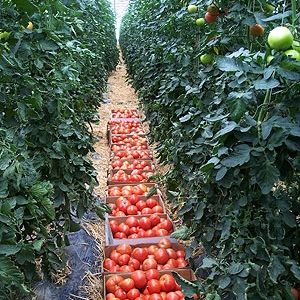I was talking with Mom yesterday afternoon, watching the LPGA Tournament of the week live from Rancho Mirage, California, and remarking on the white haze that hung in the air everywhere in the middle distance. “It’s those damned wildfires, isn’t it?” Mom snarled. And it got me wondering…
 Canada’s Brooke Henderson in the tee box at the 2020 LPGA ANA Inspiration
Canada’s Brooke Henderson in the tee box at the 2020 LPGA ANA Inspiration
in Rancho Mirage yesterday. Note the smoke hanging in the background…
Rancho Mirage, 120 miles / 190 km east of Los Angeles and hours from the nearest major fire zone, is still being affected by the fires, in as much as their smoke is blanketing the entire state, as it is – thanks to the prevailing high-level winds – many of the neighbouring states. And that’s not only bad for folks with breathing issues. It’s also potentially ruinous for billions of dollars worth of winter-harvest crops now growing in fields across California’s Central Valley, as well as in Arizona and New Mexico.
What’s the problem?
According to horticulturalists, there are several issues connected with the wildfire smoke. Depending on what is burning in the path of the fires, and how thick the smoke is, the ‘fallout’ ash and combustion gasses From the fires may themselves be toxic, or may otherwise taint the flavour and other physical qualities of the growing crops. Heavy smoke is also limiting the amount of sunshine and warmth crops are getting every day, which could delay the harvest or even kill some delicate Fruits and Veggies.
How serious is the problem?
I’ve discovered that Dr. Sylvain Charlebois, Professor and Senior Director at the Agri-Food Analytics Lab at Dalhousie University in Nova Scotia has been asking the same questions I have, and he’s leveraged his resources to find answers, which he has shared in a new online article:
“Each year, Canada imports about $3.1 billion worth of food from California, according to the California Department of Food and Agriculture,” Charlebois reports. “We import a great variety of products. Other than wine, the foods we import the most are lettuce, almonds, strawberries, raisins, oranges, cauliflower, grapes, pistachios, onions, spinach, and carrots. For the fall and winter months, the United States, and especially California, plays a key role in replenishing our grocery baskets. With our northern climate, we need import options to keep the cost of our food at a reasonable level. It has been this way for a long time.
“With a relatively strong Canadian dollar these days, there was nothing to worry about too much. COVID has made things a little more difficult over the last six months, of course, but our food security has never really been compromised. Obviously, Mother Nature had other plans.”
Why is the wildfire problem more serious this year?
First, Charlebois notes, the season started earlier than usual and there are more fires burning simultaneously than usual – by far. At last count, there were more than 8,000 (large and small) on the books for this year already, and more than 3 million acres / 12 million hectares had been destroyed – including dozens of entire communities.
He also explains that the California wildfire season usually starts in July and ends when the first heavy winter rains come in the Fall (usually in November), but the usual rains may not be enough to defeat the super-fires now raging out of control by themselves. And that may be too late for the vital crops already deemed under threat in U. S. southwest.
How would Canada cope?
Obviously, we would have to find other sources of Fresh Fruits and Veggies – South America and Asia – and chances are their produce would be significantly more expensive to put on supermarket shelves, once it was shipped to North America. No to mention that other buyers – notably European countries and the UK – would also be ‘bidding’ for supplies in the resulting shortage. Remember those $8.00 Cauliflowers of a few years back? We could be looking at prices like that again in a few months.
Charlebois says Canada must look to its existing, proven domestic Tomato, Mushroom and Cucumber cultivation methods as models for the production of other fruits and Veggies. Greenhouse growing, under glass or plastic, can deliver as many as three crops a year, in rotation. (See photo, top of page.) Bonuses include more uniform Fruits and Veggies, higher yields, faster maturation and the luxury of Produce ripened on the vine, rather than picked ‘green’ to survive long-haul shipping. We may get cold in the winter, but we also get enough bright, summery winter days to heat the air in those greenhouses and grow most of the popular types of produce we as consumers demand year around.
“Traditional greenhouses, rooftop greenhouses or integrated agricultural spaces such as vertically stacked hydroponic crops, are some of the scenarios,” Charlebois suggests. “In many parts of the country, energy is clean, and space is cheap, and many regions can dream of feeding [their] citizens affordable products while developing other markets.”
My take
So, the news is – or could be – better than I thought! I also hasten to mention The Netherlands’ Polder-culture intensive farming technique as an interesting model for Canadian growers who want to make the most of their resources.
Here in my town – one of coldest National Capitals in the world – winter Tomatoes from the U.S. southwest usually cost as much as $2.49 – $2.89 per lb. while locally-produced fresh greenhouse tomatoes may only cost a little more: Maybe $3.29 per pound ‘in season’. You’d think ours would cost a lot more, by comparison, but we don’t have pay the added cost of trucking U.S. Tomatoes north from California, Lettuce from Arizona, and Berries from New Mexico and Texas. And as I said, if you manage the greenhouse environments properly, the Sun gives us almost all the free energy we need to heat them.
The lesson here is, we don’t have to suffer; we just have to make the necessary investment to set up our own produce greenhouse system within minutes of our own supermarkets, and get used, as consumers, to paying a small additional premium for winter Fruits and Veggies. Could also be a good way to at least buffer the onset of global warming…
~ Maggie J.

